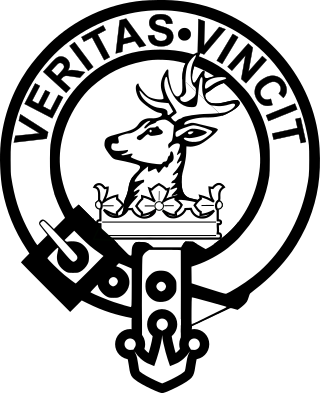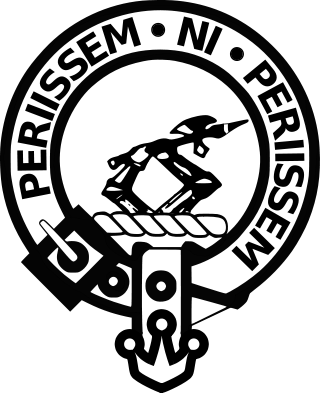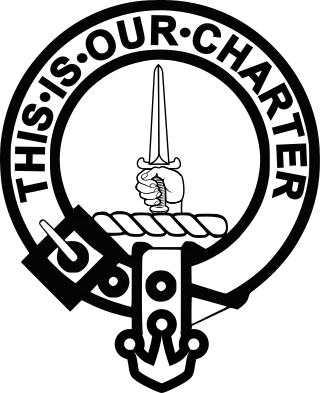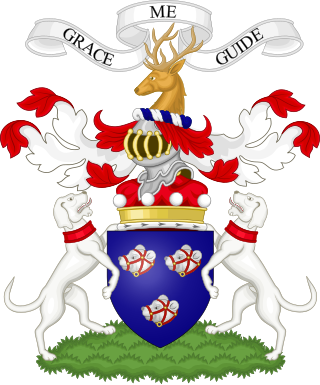
Lord Elphinstone is a title in the Peerage of Scotland created by King James IV in 1510.

Clan Keith is a Highland and Lowland Scottish clan, whose Chief historically held the hereditary title of Marischal, then Great Marischal, then Earl Marischal of Scotland.

Clan Anstruther is a Scottish clan.

Clan Gordon is a Highland Scottish clan, historically one of the most powerful Scottish clans. The Gordon lands once spanned a large territory across the Highlands. Presently, Gordon is seated at Aboyne Castle, Aberdeenshire. The Chief of the clan is the Earl of Huntly, later the Marquess of Huntly.

Clan Fraser is a Scottish clan of the Scottish Lowlands. It is not to be confused with the Clan Fraser of Lovat who are a separate Scottish clan of the Scottish Highlands. Both clans have their own separate chief, both of whom are officially recognized by the Standing Council of Scottish Chiefs.

Clan Murray is a Highland Scottish clan. The chief of the Clan Murray holds the title of Duke of Atholl. Their ancestors were the Morays of Bothwell who established the family in Scotland in the 12th century. In the 16th century, descendants of the Morays of Bothwell, the Murrays of Tullibardine, secured the chiefship of the clan and were created Earls of Tullibardine in 1606. The first Earl of Tullibardine married the heiress to the Stewart earldom of Atholl and Atholl therefore became a Murray earldom in 1626. The Murray Earl of Atholl was created Marquess of Atholl in 1676 and in 1703 it became a dukedom. The marquess of Tullibardine title has continued as a subsidiary title, being bestowed on elder sons of the chief until they succeed him as Duke of Atholl.

Clan Charteris is a Scottish clan of the Scottish Lowlands.

Clan Crichton is a Lowland Scottish clan that historically ruled Dumfries.

Clan Cranstoun is a family of the Scottish Lowlands.

Clan Colville is a Lowland Scottish clan.

Clan Lindsay is a Scottish clan of the Scottish Lowlands.

Clan Irvine is a Scottish clan.

Clan Haldane is a Lowland Scottish clan.

Clan MacMillan is a Highland Scottish clan. The Clan was originally located in the Lochaber area of the Scottish Highlands during the 12th century. The clan supported Robert the Bruce during the Wars of Scottish Independence, but later supported the Lord of the Isles in opposition to the Scottish Crown. During the Jacobite rising of 1745 the clan was divided with some supporting the Jacobites and others not taking part in the rebellion.

Clan Maitland is a Lowland Scottish clan.
Clan Straiton, also called Straton or Stratton, is a Lowland Scottish clan. The clan does not currently have a chief therefore it is considered an Armigerous clan.

Clan Stewart (Gaelic: Stiùbhart) is a Scottish Highland and Lowland clan. The clan is recognised by Court of the Lord Lyon; however, it does not have a Clan Chief recognised by the Lord Lyon King of Arms. Because the clan has no chief it can be considered an armigerous clan; however, the Earls of Galloway are now considered to be the principal branch of this clan, and the crest and motto of The Earls of Galloway's arms are used in the Clan Stewart crest badge. The Court of the Lord Lyon recognises two other Stewart/Stuart clans, Clan Stuart of Bute and Clan Stewart of Appin. Clan Stuart of Bute is the only one of the three clans at present which has a recognised chief.

Clan Swinton is a Scottish clan of the Scottish Lowlands.

Elphinstone is a village in East Lothian, Scotland. It lies 1.6 miles (2.6 km) south-west of Tranent on the B6414, and 1.24 miles (2.00 km) north-west of Ormiston.

Clan Forbes is a Highland Scottish clan from Aberdeenshire, Scotland.





















